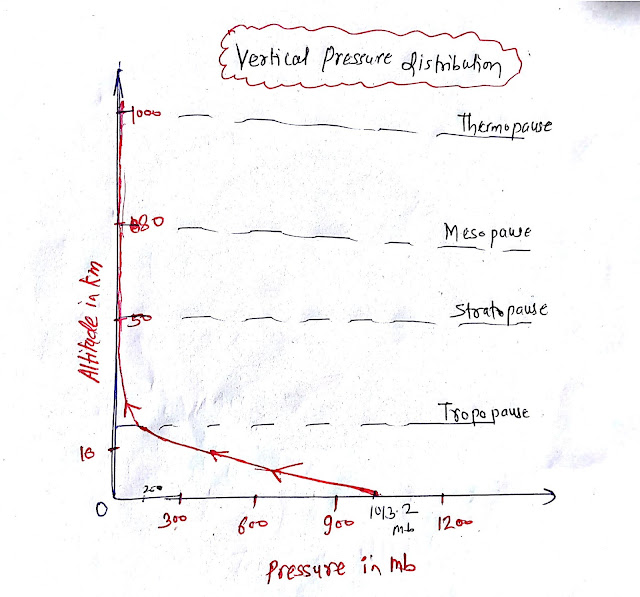Table of Contents
- Atmospheric pressure
- Factors affecting Atmospheric pressure
- Distribution of Atmospheric Pressure
- Vertical variation of atmospheric pressure
- Horizontal variation of atmospheric pressure
- Isobars
- Distribution of World Isobars in January
- Distribution of World Isobars in July
- Pressure gradients
- The implication of low atmospheric pressure at a higher altitude
Atmospheric pressure is measured by Barometer in millibar (Mb).
Atmospheric pressure
Atmospheric pressure is the weight of atmospheric components such as dust, air, per square centimeters in a particular location is caller atmospheric pressure.Horizontally, surface pressure and temperature are inversely proportional. High insolation region such as equatorial and hot desert region has low atmospheric pressure as compared to low insolation regions such as cold desert and the r region.
On average, atmosphere pressure is lowest at the equator and highest at the poles because of average high insolation at the equator and low insolation at the poles.
Factors affecting atmospheric pressure:
Two major deciding factors of pressure:- Natural factors
- Temperature
- Atmospheric components
- Altitude
- Winds
- Artificial factors
- Global Warming
- Co2, Dust particles, water vapor
Temperature:
- Air expands when heated up and gets compressed when colled up, by this process variation in atmospheric pressure is created.
- In horizontal distribution, Atmospheric pressure is inversely proportioned to temperature. As temperature decrease from the equator to Pole whereas atmospheric pressure increase from the equator to the poles.
- Vertically distribution, atmosphere pressures are proportional to temperature as temperature decreases with altitude, so does atmosphere pressure.
Atmospheric composition:
Dust and water vapor is heavier hence atmospheric pressure is higher in humid regions and water bodies as compared to arid or semi-arid region.
Altitude:
Altitude and pressure are inversely proportional.
Winds:
Winds increase atmospheric pressure because winds blow always from high pressure to low pressure.
Dust and water vapor is heavier hence atmospheric pressure is higher in humid regions and water bodies as compared to arid or semi-arid region.
Altitude:
Altitude and pressure are inversely proportional.
Winds:
Winds increase atmospheric pressure because winds blow always from high pressure to low pressure.
Global warming:
Co2, dust particles, water vapor:
- Temperature increases and atmospheric pressure decreases.
Co2, dust particles, water vapor:
- Co2 is heavier gas and the presence of Co2 increases the atmospheric pressure.
- Dust particles also increase atmospheric pressure.
- Water vapor from the dam and water bodies also increases the atmospheric pressure.
Distribution of Atmospheric Pressure
- Vertical Variation of Pressure
- Horizontal Variation of Pressure
Vertical distribution:
Atmospheric pressure does not get decrease at the same rate as altitude.
The following are atmospheric pressure.
- At sea level: 1013.25 millibars.
- 1 km: 898.76 millibar
- 10 km: 265 millibars
- At 100 km: nearly zero.
 |
| Vertical distribution of Atmospheric Pressure |
Vertical pressure gradients are more as compared to horizontal pressure gradients. Still, strong upward winds do not flow, because it is balanced by nearly equal and opposition gravitational force.
Horizontal distribution of atmospheric pressure
- Pressure gradients are not much on surfaces of the earth, but small variation in pressure is highly significant in winds velocity and direction.
- The horizontal distribution of atmospheric pressure is studied by drawing isobars.
- The low-pressure system is enclosed by one or more isobars with the lowest pressure at the center.
- In the same way, high pressure is enclosed by one or more isobars with the highest pressure at the center.
- Since July and January are the wet months for a larger portion of the earth, hence we study the isobars of January and July month.
Isobars
The line connecting the location has the same atmospheric pressure and is drawn from west to east on earth.Distribution of Isobars in January month:
 |
| Isobar in January |
Distribution of Isobars in July:
 |
| Isobar in July |
Pressure gradients:
It is the rate of change of horizontal atmospheric pressure at a given point in time. Pressure gradients are strong when isobars are closer.Implications of low atmospheric pressure in higher altitude
- Respiratory problems:
- When we go at higher altitudes, molecules form of oxygen decrease only atom oxygen is found. We have a habit to inhale molecules from oxygen, and thus humans face respiratory problems at higher altitudes.
- Due to low atmospheric pressure, leaking in fountain pens.
- Bleeding from skins.
- The boiling point gets decreases and the time of cooking food increases.
You may like also:
ConversionConversion EmoticonEmoticon